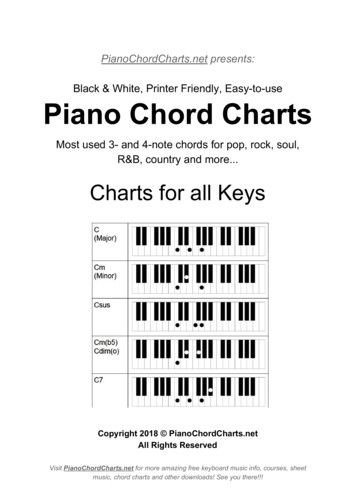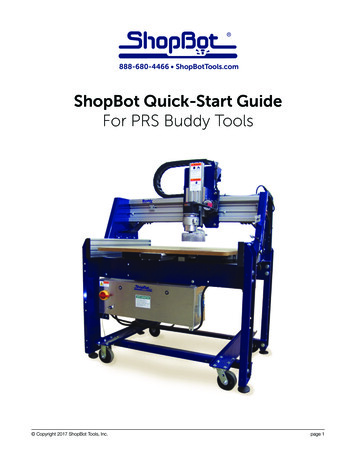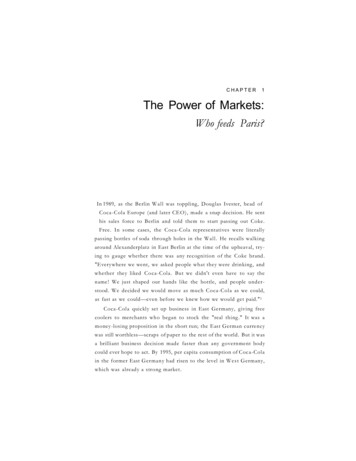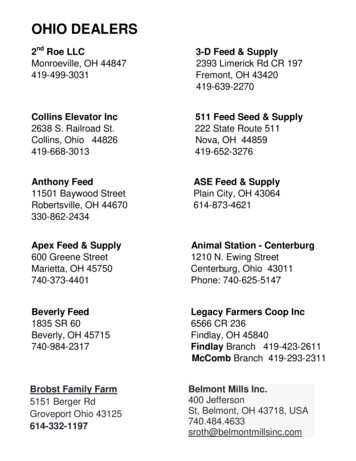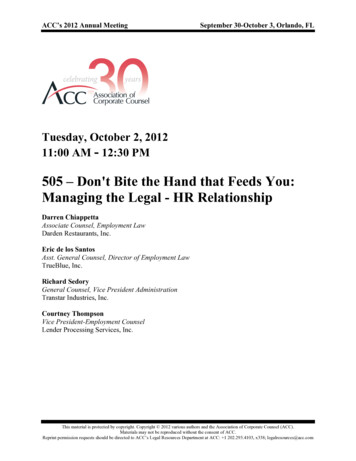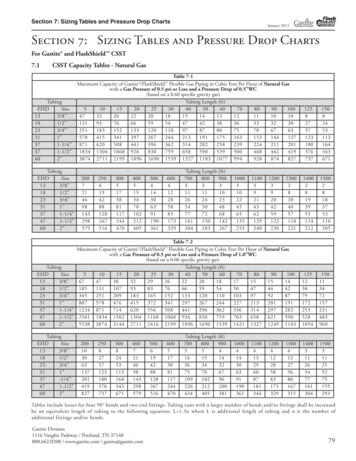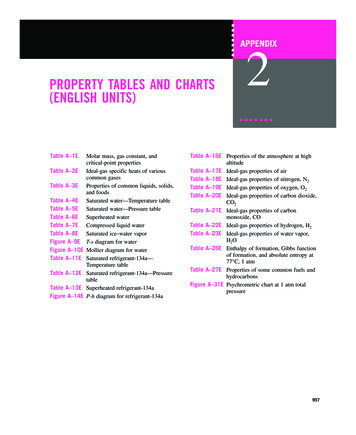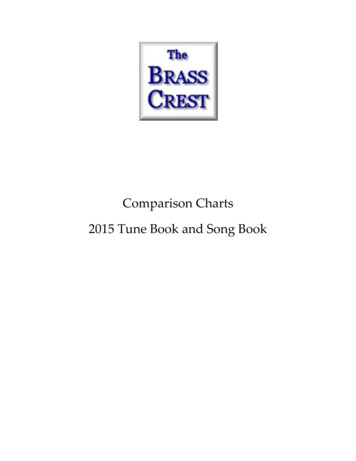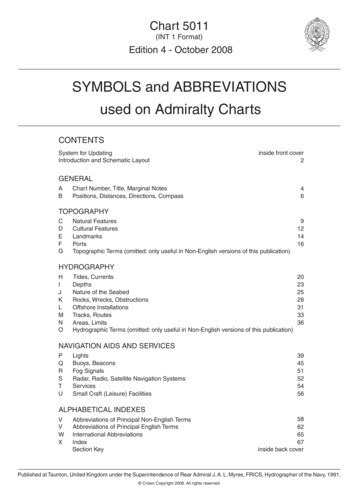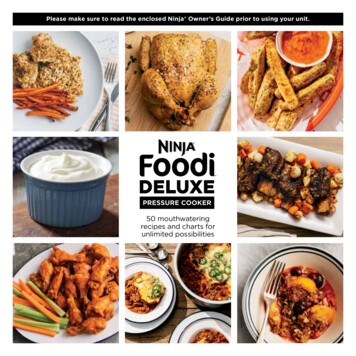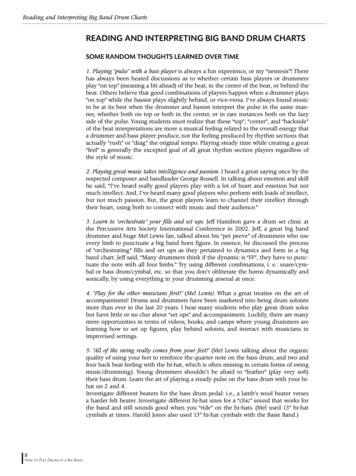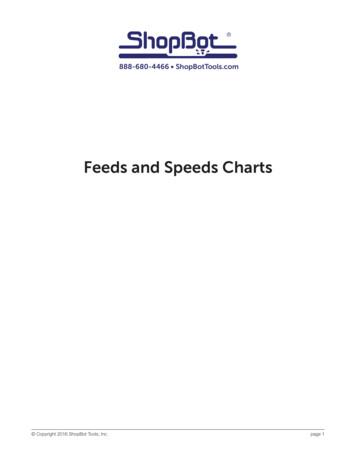
Transcription
888-680-4466 ShopBotTools.comFeeds and Speeds Charts Copyright 2016 ShopBot Tools, Inc.page 1
Feeds and Speeds Charts July 21, 2016 Copyright 2016 ShopBot Tools, Inc.page 2
Feeds and Speeds Charts July 21, 2016Table of ContentsIntroduction.5Manufacturer settings for bits.5Chip load calculator.6Feeds and speeds charts.9Soft wood.9Hard wood.10Medium Density Fiberboard (MDF).10Soft plywood.11Laminated chipboard.11Laminated plywood.12 Copyright 2016 ShopBot Tools, Inc.page 3
Feeds and Speeds Charts July 21, 2016 Copyright 2016 ShopBot Tools, Inc.page 4
Feeds and Speeds Charts July 21, 2016IntroductionA challenge of getting a good CNC cut is in selecting the best cutting speed (feed rate) and router/spindle RPM (speed of rotation). Feeds and speeds are a critical part of machining and should be fullyunderstood before deviating from recommended settings. A primary concern of machining is chipload, which is a representation of the size of the chips produced during cutting. The goal is to get themaximum chip load possible to increase productivity, reduce heat, and prevent premature dulling.When chip load is too small, bits will get too hot and dull quicker. When chip load is too high, the toolwill deflect creating a bad surface finish and, in extreme cases, chip or break the bit.Chip load is a function of three different parameters: feed rate, RPM, and number of flutes on the tool.Chip load is the thickness of the chunk of material taken by a tooth of the cutter. This is determinedby how fast the cutter is moving forward into the material and how fast it is turning (Chip load FeedRate / [RPM x number of flutes]). This formula provides a starting point for determining the most suitable parameters for any cutting situation.A ShopBot tool has either a router or a spindle. The advantage of a spindle is that speed can be veryprecisely controlled. This allows for optimization of cuts. A router does not have a precise speedcontroller, so the actual speed of the router is directly correlated to the depth of cut, material, and feedrate. For routers, these numbers will be a starting point, but will have to be adjusted for real life conditions. This is necessary because routers tend to run lower than the setting on the router indicates;settings should be recorded as they will work for similar cuts in similar material. It is recommended tostart with low numbers to ensure it is within an acceptable range for the tool.There is considerable overlap in the range of parameters; it will be necessary to test in this range forthe best speed selection for a particular cutting or machining operation. Below is the strategy that bitmanufacturer Onsrud suggests. This works particularly well for routers.Optimizing feed rates and speeds:1. Start off using an RPM derived for the chip load for the material being cut (see charts).2. Increase the cutting speed (feed rate) until the quality of the part’s finish starts to decrease or thepart is starting to move from hold downs. Then decrease speed by 10%.3. Decrease RPM until finish deteriorates, then bring RPM back up until finish is acceptable.4. This optimizes RPM and speed to remove the largest possible chips.To reduce the amount of work needed, a range of feeds and speeds is provided to start at (step 1above). To increase performance, optimize feeds and speeds as detailed above. If there are any surface finish problems, adjust until performance is acceptable. If there are a lot of work holding issues, itmay be necessary to revisit the hold down method to ensure it is adequate.Manufacturer settings for bitsMost manufacturers provide optimal speeds and feeds for their bits. There are numerous calculatorsavailable online that can provide rough numbers. These calculators should work fine, but may not beoptimized for each particular bit. The manufacturer will still be the best resource, as most reputablecompanies have information and live support available to help users of their tools utilize them properly.ShopBot recommends Onsrud tools.If doing production work in a certain type of material, it would be best to purchase a bit made for thattype of cutting. If performing a number of different materials, then a more general bit could be used. Copyright 2016 ShopBot Tools, Inc.page 5
Feeds and Speeds Charts July 21, 2016http://www.onsrud.com/xdoc/FeedSpeedsChip Load per cutting edge.IPS Inches Per Second.IPM Inches Per Minute.RPM Revolutions Per Minute.# of cutting edges # of flutes.**typically true unless stated otherwise by manufacturer.Chip Load Feed Rate (IPM) / (RPM x # of cutting edges)Feed Rate (IPM) RPM x # of cutting edges x Chip LoadSpeed (RPM) Feed Rate (IPM) / (# of cutting edges x Chip Load)IPM IPS x 60Depth of cut: A function of cutting edge diameter set by manufacturer.Onsrud bits are typically allowed a cut depth per pass equal to the cutting edge diameter unlessotherwise specified. For a deeper cut, it will be necessary to reduce the chip load. For twice the depthof cut, reduce the chip load per tooth by 25% and for triple the depth of cut, reduce the chip load by50%. If doing this, it will be necessary to calculate the feed rate and speed instead of using the chart.Example using a 1/4” or 0.125” bit – Straight V Carbide Tipped Endmill SB# 13642:This bit is used for soft wood, at a depth of 1/2” (two times the diameter). The chart cannot be usedfor this calculation. Start with the middle of the range of recommended chip load provided on the chart((.006 .004)/2 .005). Reduce that by 25% to allow for the deeper cutting depth (0.75x0.005 0.00375).Assuming that cutting will be performed at an RPM of 18,000 and that this tool only has one flute.Let’s use the ShopBot 3 “Chip Load Calculator” to decide what value to start with.Chip load calculatorThe “Chip Load Calculator” comes included in the ShopBot3 software. It can be accessed by going to Tools Chip LoadCalculator (TL). Copyright 2016 ShopBot Tools, Inc.page 6
Feeds and Speeds Charts July 21, 2016In the previous example values were provided to calculate the feed rate.RPM: 18,000Chip load: 0.00375, Depth of cut: 2 x Diameter 1/2”Flutes: 1Enter these into the calculator and click “Calculate.”This now provides the values needed to create an entry intothe tool database in VCarve Pro.Diameter: 0.25”Pass depth: 0.5”Spindle speed: 18000 RPMFeed rate: 1.125 inches/sec Copyright 2016 ShopBot Tools, Inc.page 7
Feeds and Speeds Charts July 21, 2016The data is now available to input into the CAM software.The tool info sheet for VCarve Pro is shown. Copyright 2016 ShopBot Tools, Inc.page 8
Feeds and Speeds Charts July 21, 2016Feeds and speeds chartsThese charts have been taken from Onsrud’s recommendations and calculated in order to save timefor the bits provided in the ShopBot bit kit. For further information, Onsrud series numbers are provided. ShopBot numbers are also provided for an easier, streamlined ordering experience. Onsrud provided numbers are cut depths, chip loads, and flutes. The exception to this rule is the “Carbide TippedSurfacing Cutter” which has all values provided by Onsrud. Any tools with no values provided are notlisted by Onsrud, but if they are contacted about a specific use, they may provide some base numbersfrom which to calculate.The “Chip Load Calculator” in ShopBot 3 was utilized with a starting RPM of 18,000 on all tools tofind the calculated feed rate. Any deviations from provided numbers should be verified and adjustedthrough recalculation in ShopBot 3 “Chip Load Calculator.”Soft woodNameSB#OnsrudCutSeries1” 60 degree Carbide VChip Load per Flutesleading edgeFeedFeed rateRate 18,0001355591-0001/2-3/4cutter1/4” Straight V CarbideTipped End Mill1/2” Straight V CarbideTipped End Mill1/4” Upcut Carbide EndMill1/4” Downcut CarbideEnd Mill1/4” Upcut Carbide EndMill1/8” Tapered CarbideUpcut Ball End Mill1-1/4” Carbide TippedSurfacing Cutter Copyright 2016 ShopBot Tools, Inc.xD2200-60012,000-1/8"16,000page 9
Feeds and Speeds Charts July 21, 2016Hard woodNameSB#OnsrudCutSeries1” 60 degree Carbide VChip Load per Flutesleading edgeFeedFeed rateRate 3-.00521.8-3.018,0001355591-0001/2-3/4cutter1/4” Straight V Carbide90-12618,000Tipped End Mill1/2” Straight V CarbideTipped End Mill1/4” Upcut Carbide EndMill1/4” Downcut CarbideEnd Mill1/4” Upcut Carbide EndMill1/8” Tapered CarbideUpcut Ball End Mill1-1/4” Carbide TippedSurfacing Cutter2200-600xD12,000-1/8"16,000Medium Density Fiberboard (MDF)NameSB#OnsrudCut1” 60 degree Carbide 521.8-3.018,0001355591-0001/2-3/4SeriesChip Load per Flutesleading edgeFeedFeed rateRate (ips)(ipm)RPMMaxCut18,000cutter1/4” Straight V CarbideTipped End Mill1/2” Straight V CarbideTipped End Mill1/4” Upcut Carbide EndMill1/4” Downcut CarbideEnd Mill1/4” Upcut Carbide EndMill1/8” Tapered CarbideUpcut Ball End Mill1-1/4” Carbide TippedSurfacing Cutter Copyright 2016 ShopBot Tools, Inc.xD2200-60012,000-1/8"16,000page 10
Feeds and Speeds Charts July 21, 2016Soft PlywoodNameSB#OnsrudCutSeries1” 60 degree Carbide VChip Load per Flutesleading edgeFeedFeed rateRate er1/4” Straight V Carbide90-12618,000Tipped End Mill1/2” Straight V Carbide18,000Tipped End Mill1/4” Upcut Carbide EndMill1/4” Downcut CarbideEnd Mill1/4” Upcut Carbide End18,000Mill1/8” Tapered Carbiden/an/an/a200-60012,000-1/8"Upcut Ball End Mill1-1/4” Carbide TippedSurfacing Cutter2xD16,000Laminated ChipboardNameSB#OnsrudCut1” 60 degree Carbide 0-60012,000-1/8"SeriesChip Load per Flutesleading edgeFeedFeed rateRate (ips)(ipm)RPMMaxCutcutter1/4” Straight V CarbideTipped End Mill1/2” Straight V CarbideTipped End Mill1/4” Upcut Carbide EndMill1/4” Downcut CarbideEnd Mill1/4” Upcut Carbide EndMill1/8” Tapered CarbideUpcut Ball End Mill1-1/4” Carbide TippedSurfacing Cutter Copyright 2016 ShopBot Tools, Inc.xD216,000page 11
Feeds and Speeds Charts July 21, 2016Laminated PlywoodNameSB#OnsrudCutSeries1” 60 degree Carbide VChip Load per Flutesleading edgeFeedFeed rateRate -3/4cutter1/4” Straight V CarbideTipped End Mill1/2” Straight V Carbide18,000Tipped End Mill1/4” Upcut Carbide EndMill1/4” Downcut CarbideEnd Mill1/4” Upcut Carbide EndMill1/8” Tapered Carbide18,000Upcut Ball End Mill1-1/4” Carbide TippedSurfacing Cutter Copyright 2016 ShopBot Tools, Inc.xD2200-60012,000-1/8"16,000page 12
will deflect creating a bad surface finish and, in extreme cases, chip or break the bit. Chip load is a function of three different parameters: feed rate, RPM, and number of flutes on the tool. Chip load is the thickness of the chunk of material taken by a tooth of the cutter. This is determined by how fast the cutter is moving forward into the material and how fast it is turning (Chip load .
